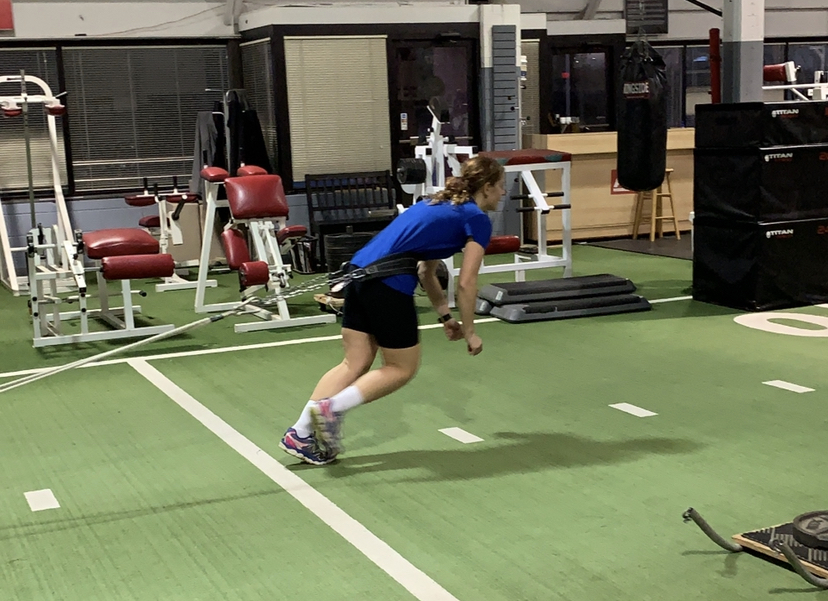
If your compassion doesn’t include yourself, it’s incomplete.
Jack Kornfield
Visit our shop for cool triathlete merchandise!
Subscribe to receive updates and exclusive content!

Right now, large chunk of world’s population is stuck at home. Gyms are closed and some are not even allowed to leave for a run. How awful! I am lucky in that I have a bike set up on an indoor trainer, so my fitness won’t all just go away. I thought though that this is a great moment to discuss importance of getting some strength training in. It’s a great moment to incorporate that into your life, since your options for cardio are limited. You should also have extra time, since you don’t have to commute. Well, unless you have kids at home. But that’s a whole another story (and go to my daughter’s page, NataliasFitness.com to deal with that 😉).
Since you’re probably stuck inside (like majority of us are), here is a pretty picture of the great outdoors (I will be adding them sporadically and off-topic, just so you have something nice to look at):

When you ask the internet if you should or should not lift weights when you’re training for endurance races, you will end up saying ‘I’m sorry I asked’. I know I sure had that feeling! There are two camps at a vicious war on each side of this fight and both have some reasonable arguments and scientific studies to throw at you. I did learn a couple of things though.

First off, if you are an endurance athlete, you are unlikely to get bulky. Doing your regular long runs, rides or swims will keep your muscle from growing huge. Well, that’s good news, since nobody wants to carry extra pounds up those hills on a bike! We don’t spend all that money on getting our bikes lighter just to make ourselves heavy!

However, replacing your endurance training sessions with weight lifting will compromise your performance during races. Well, that makes sense. It’s also not great if you lift so much that your muscle is always overly fatigued and damaged. That will compromise your ability to experience full benefits of core training sessions. Need for rest & recovery still holds true.

I have read some studies that when they made professional athletes add strength training to their routine, there was no improvement. What’s more, cyclists got slower. Woah! Not cool!

Yeah, those were the pros though. For amateurs (like myself), strength training did improve overall fitness. Speaking of improving overall fitness: this is where the real deal with strength training is hiding. Weightlifting (if done right) leads to stronger joints and ligaments. Based on personal experiences: it can also help you straighten out various imbalances in your muscle tone and help you keep correct running/ biking/ swimming form. I have a damaged hip from ages ago and general tendency to hurt myself in rather creative ways. With Diana (my personal trainer and goddess of all things fitness), we have been working on fixing all those issues. And guess what? Answer is most of the time lifting weights. At correct loads. With correct form. Very specific exercises. It made me stronger and faster. What’s more important: it helps me get over various issues faster.

So what’s the verdict? Weightlifting can be your ally in endurance training, as long as you do it the right way.
I hope you enjoyed variety of outdoor pics, too! I have been browsing IG a lot for those, since I miss being outside.
I hate chafing! I also chafe easily. Almost two weeks ago I went for a run and when I got too hot, I took off my shirt. I am still trying to heal from all the chafing caused by my weighted vest. I thought it’s a good time to figure out what’s up with that, especially since the season is just starting and I will be likely running into these issues more often.
Chafing is injury to your skin, ranging from mild redness to rawness and bleeding (haven’t you seen those men crossing marathon finish line with blood on their t-shirts?). It is caused by something repeatedly rubbing against your skin, whether it’s your own skin or fabric. Chafing may be exacerbated by:
Based on that, you should be able to guess what are some easy ways to help avoid chafing:
Sadly, you won’t be always successful at avoiding chafing. Your thighs and underarms are raw. Now what?
Go out there and keep going!
Visit our shop for cool triathlete merchandise!
Subscribe to receive updates and exclusive content!

For many of us, spring races have been either postponed or cancelled. I know you are disappointed. I am, too – I will be missing out on Big Sur Marathon 2020 because I can’t make it in the fall (I already have IM MD scheduled!). But your training is not wasted – you are in better shape than before. You are healthier. And now you just have extra time to prepare. Remember that racers are not the only ones impacted – there are many who rely on races for their paycheck. Those were not easy decisions for race directors, I am sure. Please stay safe and healthy. The better we are at social isolating and cutting down transmissions we are, the sooner it is over and they will be able to stop cancelling/ postponing the races. If you have an urge to say ‘but I would be fine’, remember that you can still be a carrier and it’s not all about you. In the words of Mr. Spock:
The needs of the many outweigh the needs of the few, or the one.
Remember the guy who dressed up in costume to accompany his buddy to the gym because the buddy thought that everybody would stare at him because he was fat? I have heard this many times before: I am too fat to go to the gym! People will stare at me if I go to the gym!

First of all: as a skinny person at the gym, I can honestly tell you that I don’t judge you negatively for showing up with a few extra pounds. I applaud you for your decision to make a positive change in your life. I talked about this to one of my closest friends. He also workouts at lest once per day and enjoys gym classes. He said that he goes out of his way to help and encourage people who appear to be struggling with the workout and will offer advice if asked (but won’t budge in). As to others? My observations suggest that vast majority of gym goers are busy doing their own thing and notice you only if they need to ask if you still need some piece of equipment. I am not going to claim there are no judgmental a-holes out there. Those guys are everywhere, but gym is not their natural habitat.
Secondly, I did look at various places and talked to many regular gym goers. You know what they say? Majority of them say that when they are at the gym, they are busy doing their thing and don’t watch others. And those who do notice you? They either are happy for you or want to encourage you without scaring you off.
Regardless of how many times we hear that other people don’t care about what we look like at the gym, it is a feeling one has and logic won’t always be good enough to silence the mean little voice inside your head. So here is a couple of ideas on how to cope:
I hope this helps you conquer your fear of joining a gym. Fitness is a great journey and we all have to start somewhere. Go out there and do your thing 😊
Visit our shop for cool triathlete merchandise!
Subscribe to receive updates and exclusive content!
Training for an endurance sports race takes months of hard work. While some people will hire a coach/ personal trainer, majority will stick with a pre-made plan found online (or in a book). Unfortunately, whether it’s you getting sick, your kid’s school play or a work trip (or one of many other curve balls life throws at you), life will force you to miss some workouts. Hopefully it’s something like a recovery run and not a key session, but it may be even a week or longer. Now what?
If you have a coach
First of all, if you have a high potential for life throwing you curve balls, such as frequent and hard to predict business trips or had multiple past injuries, investing in a coach would be a good idea. There is a good chance you will need help navigating life and adjusting your training plan. Trying to do it on your own, without much knowledge on the subject, you risk not reaching your goal or worse: injuring yourself.
If you are working with a coach, ask them. They know what’s going on in your training and what you are working towards. A coach will be able to determine the best course of action. After all, that’s what you pay him/ her to do, right? Your coach spent many years learning how to prepare a good training plan and has tailored it to your needs.They also understand what your body is working on and can warn you that certain workouts are keys or that doing that long run a day early won’t allow your body to recover properly after some specific session or built-up.
Allow yourself extra training weeks
If you are following a written training plan, I think this is the best course of action, especially if you are a beginner. One of my coworkers was planning her first marathon and she told me she was going to start in two weeks, giving her the exact amount of time needed before her race day. I immediately told her she is setting herself up for a failure because she is going to miss a few workouts between her start date and race day – I knew already that she was planning a move a few states away during her race training. I strongly encourage people to start a week or two early to allow for curve balls life throws at them. Number of weeks should be related to how hectic your life gets – the higher the chance for you being our of commission for more than 2-3 days, the longer lead time you will need.
Switch things around
If it’s just one workout, most likely you will be able to proceed with your plan. If it falls on a day of a key workout, move things around and maybe skip a recovery run in favor of a long run. How big of an impact it will have on your plan is related to your level of experience and general fitness. I have been running long distances for a long time now and I am very good at endurance part, so I don’t worry much about building up my mileage, as I can skip a couple of weeks and intermediary steps with relatively little penalty. However, if it’s your first time in your life going certain distance, it may really hurt. On the other hand, it may be a key workout, such as a long run when you are trying to increase your mileage and you don’t have enough weeks to squeeze in your entire progression in the time remaining. For experienced athletes, it may not be as bad – you may be able to skip a few intermediary steps and be just fine.
Another idea in the switching it up department: ok, so maybe you don’t have 3 hours required to do your long run. Can you squeeze in a 10k? You may be forced to shorten your workout, but you will still get something accomplished.
Avoid doubling up
If you miss your Monday workout, don’t do it together with Tuesday and have one in the morning and one in the evening. You are increasing the chance that your body won’t be fully recovered. Also think of my recent post about recovery and rest days: you have to give chance to your muscle to repair and rebuild. Bunching up your workouts won’t give your body a chance.
Cross training?
If you are forced to take a day (or a few) from your regular workout routine, ask yourself: can I stay active doing something else? For example: you are told to avoid high-impact sports. Maybe you can go for a swim? Or you hurt your foot and need to sit. How about weights for upper body? Hand cycle? (I used to go to a gym when they had one of those). Allow yourself to explore other options. Becoming obsessed with a plan and following it come hell or high water isn’t healthy.
Taking a break from working out
Final note: keep in mind that it takes over a week to start losing fitness when you can’t work out. I actually noticed that my times improved after I was forced to take some time off around Christmas. We are so consumed with focus on training that we forget that rest helps us gain, too.
Visit our shop for cool triathlete merchandise!
Subscribe to receive updates and exclusive content!